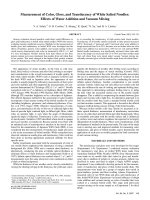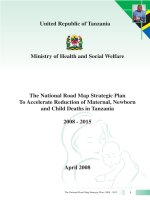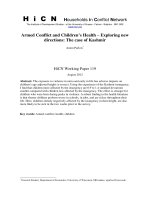Children’s Health Deficits due to Diarrhoea: Effects of Water Supply and Sanitation Systems in Slums with Different Water Logging Conditions
Bạn đang xem bản rút gọn của tài liệu. Xem và tải ngay bản đầy đủ của tài liệu tại đây (601.94 KB, 15 trang )
Journal of Water and Environment Technology, Vol. 7, No. 4, 2009
- 277 -
Children’s Health Deficits due to Diarrhoea: Effects of
Water Supply and Sanitation Systems in Slums with
Different Water Logging Conditions
Kabirul Ahsan MOLLAH*, Kei NISHIDA*, Naoki KONDO* and
Zentaro YAMAGATA*
* Interdisciplinary Graduate School of Medicine and Engineering, the University of Yamanashi
4-3-11, Takeda, Kofu, Yamanashi 400-8511, Japan
ABSTRACT
This population-based epidemiologic study investigated the associations of individuals’ socio-
demographic statuses, sanitary systems and habits, water supply and drainage conditions with
diarrhoea incidences among 707 children younger than 5 years who were living in slum
communities with various water logging patterns in Dhaka, Bangladesh. We conducted a home-
visiting survey during the pre-monsoon period from December 2006 to April 2007. Nine slum
communities were selected that had been experiencing five different water logging conditions.
One non-water logging community was selected as a control. The Disability Adjusted Life Years
(DALYs) were calculated using data on diarrhoea morbidity and mortality. Although DALYs
lost because of diarrhoea were very small in a non-inundation type community, but were the
highest in persistent drainage inundation type communities. Among the factors correlated with
DALYs, control variables for mother’s illiteracy and household income strongly attenuated
most of these correlations to statistical null, except for mother’s age (less than 15 years-old),
using hanging latrine and not washing hands before eating, and after defecation. In conclusion,
water logging conditions and socio-economic statuses may strongly contribute to diarrhoea
incidence in the city’s slum communities. In such communities, interventions to address both
water logging and socio-economic conditions may be critical for reducing diarrhoea incidences.
Keywords: DALY, diarrhoea, poor urban community, water logging.
INTRODUCTION
Poor environmental sanitation and the unsafe disposal of human and solid wastes
contribute to the high incidence of water-borne diseases, including diarrhoeal diseases,
malaria and dengue fever (WHO/UNICEF 2001). Many of these infections occur in
developing nations that have sanitation problems (Nsubuga et al. 2004). In these
nations, most low-lying lands used for squatter settlements or slums have hanging
latrines or open-field defecation. Due to lack of access to potable water supplies, the
poor rely mainly on shallow wells, rivers, streams and ponds for daily water needs
(Nevondo and Cloete 1999). In most cases, water from these sources, which may be
faecally contaminated, is used directly without treatment (WHO 1993). During 2002, it
was estimated that 4% (60.7 million Disability Adjusted Life Years [DALYs]) of the
global burden of disease and 1.6 million deaths per year were attributed to unsafe water
supplies and sanitation, including lack of hygiene (WHO 2002).
Acute diarrhoeal diseases are the major causes of morbidity and mortality in developing
countries, such as Bangladesh, where 1 in 10 children die before their fifth birthday
(Bern et al. 1992; Petri et al. 2000). Bangladesh’s capital city, Dhaka, is a typical flood-
prone urban habitat. It is periodically devastated by floods, resulting in stagnant water
and drainage problems (JICA 1990; JICA 1987; SWMC 1997). The inadequate
Address correspondence to Kei NISHIDA, Interdisciplinary Graduate School of Medicine and
Engineering, the University of Yamanashi, Email:
Received June 18, 2009, Accepted August 27, 2009.
Journal of Water and Environment Technology, Vol. 7, No. 4, 2009
- 278 -
drainage in nearly 60% of slums assures that many slums are at risk of flooding (CUS
et al. 2006), faecal contamination (Fawell 2007) and consequent cases of diarrhoea,
whereas childhood diarrhoea is not prevalent in areas with higher elevations (Brussow
1993). Inavailability of sanitary facilities also contributes.
Among slums in Dhaka, only over 35% of households use hygienic latrines, whereas,
for garbage management, 35% just use vacant land and water bodies as waste disposal
sites. This neglected population in slums has become a major reservoir for a wide
spectrum of adverse health conditions, including most prevalent diarrhoeal diseases,
intestinal problems, fever and skin diseases (Rahman et al. 1989; Hussain et al.
1999;Rahman and Shahidullah 2001; Sclar et al. 2005), and has a high infant mortality
rate (Hoque and Selwyn 1996; Arifeen et al. 2001). Consequently, urban slum dwellers
have been identified as a particularly vulnerable group regarding health status by
Bangladesh’s Poverty Reduction Strategy Planning (PRSP) of the Government of
Bangladesh, 2005.
In 2000, the United Nations Millennium Declaration pledged to tackle this challenge by
setting specific goals and attempting to achieve significant improvements in the lives of
at least 100 million slum dwellers worldwide by the year 2020 (UN 2007; Riley 2007).
In light of these worldwide phenomena, the government of Bangladesh is also
committed to achieving the targets embodied in the UN Millennium Declaration by
2015 (World Bank 2006a, 2007). Thus, demonstrating the impact of water logging on
diarrhoeal incidence in Dhaka City, and how household and individual factors interact
with this impact are of utmost necessity in finding prime locations for slum
development programmes.
The objectives of this study are: (1) to estimate variations in children’s diarrhoea
incidence among Bangladesh’s urban slum communities based on their inundation
conditions, and (2) to assess the populations’ demographic factors, socioeconomic
status, sanitary facilities and attitudes as potential factors associated with diarrhoea
incidence among slums with varying flood and inundation conditions.
METHODS
Study population
Based on flood and inundation experience, slum communities in Dhaka were selected
from different representative water logging situations categorized in terms of duration
and type of inundation. We proposed 4 levels based on duration of inundation (short-
term, long-term, persistent and non-inundation) and 5 types of inundation (rainy,
stagnant-water, heavy-rainy, monsoon-flood and drainage-water inundations). Ten sub-
districts were selected by integrating information regarding water logging for the past
5–10 years that was obtained from interviews with the concerned authorities and
dwellers as well as on-site measurements from a preliminary survey conducted in
December 2006. The slum communities selected were situated within 1 km from the
Urban Development Centre project offices of the Slum Development Department of the
Dhaka City Corporation (Table 1 and Figure 1). Thus, for the ‘code name’, we used the
initials of inundation duration, inundation type and the respective sub-district name of
Journal of Water and Environment Technology, Vol. 7, No. 4, 2009
- 279 -
each studied community; the code name will be used for the following discussion as
corresponding to each community.
Table 1 - Inundation categories and code names of studied slum communities
Inundation category
Sub-districts
Ward Code name
Duration based Type based
Short-term Rain
y Mirpur
1
5 SRM
Heavy-rainy Uttara
1SHU
Drainage-water Gulshan
19 SDG
Long-term Sta
gnant-water Demra
86 LSD
Heavy-rainy Tejgaon
37 LHT
Monsoon-flood Khilkhet
17 LMK
Persistent Drainage-water Lalbagh
65 PDL
Heavy-rainy Sabujbagh
27 PHS
Stagnant-water Muhammadpur
47 PSM
None None Jatrabari-Dhalpur
29 NCD
A household was defined as people sharing the same cooking pot (Hussain et al. 1999).
Using this definition, 820 households in 10 sub-districts were identified during the
preliminary survey. Of the 350 households satisfying the predefined criteria (35
households from each community), presence of children less than 5 years of age, water
supply and no improvement in sanitation (WHO/UNICEF 2003; WHO/UNICEF JMP
2000) were selected for additional questionnaire surveys. Informed consent was
obtained from the parents or guardians.
•
SHU
•
LMK
•
SDG
•
LHT
•
PHS
•
NCD
•
LSD
•
PDL
•
PSM
•
SRM
N
DHAKA CITY
Sub district
boundaries
Canals
River
Embankment
1 0 1 2 km
Fig. 1 - Study site map in Dhaka, Bangladesh; adapted by authors. (Source:
)
Journal of Water and Environment Technology, Vol. 7, No. 4, 2009
- 280 -
Diarrhoea incidence and questionnaire
Among water-borne diseases, diarrhoea is a condition of morbidity that is relatively
easy to monitor- as it occurs rather frequently. Respondent mothers easily understand
its definition, and there is little variation of symptoms from mothers’ perceptions
(Killewo and Smet 1989): the occurrence of 3 or more loose, watery or mucous stools
in the previous 24 h (WHO 2009). We followed the definition of acute diarrhoea by the
World Health Organization (WHO) and UNICEF: an attack of sudden onset that
usually lasts 3–7 days but may last up to 10–14 days (Park 1997). We used a period of
3 intervening diarrhoea-free days to differentiate a new incidence of diarrhoea (Baqui et
al. 1991). The Child Health Epidemiology Reference Group of WHO (WHO/CHERG
2004) summarized a table for the definition of diarrhoeal deaths that was used in this
survey for verbal autopsy, which has a very good agreement with hospital diagnosis
(Kalter et al. 1990; Pacque-Margolis et al. 1990).
In April 2007, investigators asked each mother to follow her child/children for 2 weeks
after recruitment, and during a preliminary visit, they described how to confirm the
presence of diarrhoea. They also demonstrated how to mark the day that symptoms first
started and the day that the illness ended or the child succumbed to the illness. The
information was reported to investigators at the follow-up two weeks later. The 2-week
interval was chosen because diseases and symptoms assessed and reported by
inhabitants can be imprecise; high reliability depends on shorter recall periods (Byass et
al. 1994). Final data were recorded only if the data were consistent with the mothers’
performance levels in defining the symptoms and counting the days of illness.
We developed a series of household-level questionnaires based on the World Bank
(World Bank 1999), WHO (WHO 1991) and United Nations guidelines (UN 2005,
2001, 1998, 1984). These questionnaires had modified wording to improve suitability
for the study population after pre-testing during a preliminary visit. The interview
survey requested information regarding hygiene practices, water supply and sanitation
situations, household income, maternal educational attainment and demographic
characteristics (Mollah et al 2009).
Septic tanks and pour-flush latrines connected to a sewer line were considered as
sanitary latrines for the purpose of this study. Unsanitary types consisted of cesspools,
pit latrines and storage tank facilities; open and homemade latrines consisted of
hanging latrines. Drainage pipes from latrines were usually connected to sewer lines,
and human excreta were directly discharged without treatment.
Calculation of Disability Adjusted Life Years (DALY)
Morbidity and mortality cases of diarrhoea for children less than 5 years old and their
significance were used to estimate DALYs in each community (Murray and Acharya
1997). DALYs combine years of life lost (YLL) with years lived with disability (YLD).
These are standardized using severity weights (Murray et al. 1996) and durations of
morbidity (Murray et al. 2002). DALYs, due to premature mortality, are calculated
using standard expected YLL from model life tables and, due to disability from age a to
age (a + L), consists of the following equation derived by Murray (1994) and Homedes
(2000):
Journal of Water and Environment Technology, Vol. 7, No. 4, 2009
- 281 -
(Eq. 1)
Here, β is an age-weighting parameter, C is an age-weighting correction constant, r is a
time preference discount rate, D represents stages of physical disability that
consequently affected daily living activities (productive activities, for instance school or
work), a is set on an age at which the child suffered a particular disease or died and L
assumes 2 value sets, YLD and YLL.
The DALY formula was established with a lost time concept of disability due to
suffering from any specific disease, including fatality. The value was estimated based
on life expectancy in a developed country (e.g. Japanese life expectancy for male and
female) as well as an age-weighted lost time discounting value for the developed world,
used for global DALY calculation. Accordingly, we decided upon C (0.16243), β (0.04)
and r (0.03) as the default values for a global context. In contrast, applied available
local data set for D = 1 in case of death, 0.3, 0.5 in case of diarrhoea, a = 1, 3 for each
age group (assumed from the interview survey, average age of infant and child,
respectively) and L, for morbidity calculation, YLD = 0.21, 0.28, 0.36, 0.43 (assumed
from the interview survey) and, for mortality calculation, YLL = 62 years for male and
63 years for females in Bangladesh as of 2005 (WHO 2007).
Furthermore, the default values for β, C and r have no influence for the age group
younger than 15, considered as work force, which sets the priority for the time lost at
this age. For D, its influence depends on each subject’s degree of end point (range 0–1).
This requires quantitative and qualitative estimations to define the value of D, a
technical task for this study as well. The value for L also influences a greater variation
for cases with very low life expectancy, whereas for a, its influences are lower and
higher at a cut-off age of 20.
The team physician assessed the degree of dehydration according to the WHO criteria
(WHO 1990). The severity of each diarrhoeal disease incidence was calculated using a
numerical scoring system (Ruuska et al. 1990), which we modified into 2 classes.
Accordingly, in our study, D is decided with numerical values for adjusted morbidity
days and scored for different severities, which also substantially reduced error on the
value based only on qualitative estimation. All of the above default values for β, C and
r have an influence, but only for ages over 5 years. Thus, in our study, these imparted
no influences, as our subjects were children less than 5 years of age.
Statistical analyses
After the DALY calculations by community types, we evaluated the factors that
correlated with the DALYs lost among the 10 communities using Pearson correlation
coefficient and multivariate partial correlation analyses. All analyses used SPSS
software version 15 (SPSS Inc., Chicago, USA, 2007).
RESULTS AND DISCUSSION
Forty percent of households had 7 or more family members, and 40% of the studied
households had monthly household incomes less than 30 USD. Age less than 15 years
Journal of Water and Environment Technology, Vol. 7, No. 4, 2009
- 282 -
and illiteracy of respondent mothers were also higher (greater than 40%) in this survey,
except for the non-inundated community (NCD), compared to the national average
(BBS 2007) (Figure 2-a).
In the NCD, tap water was used in 100% of households and 80% had sanitary latrines,
whereas in other communities, only 23–54% used tap water and 0–9% had sanitary
latrines (Figure 2-b and c). In particular, slums under persistent water logging
conditions were likely to have worse sanitary conditions (i.e. relatively higher rates of
unsanitary hanging latrines or no latrine) (Figure 2-c).
Almost 67% of households among the surveyed households did not practice any
type of water treatment at home, while around 14% and 17% used only simple filtering
with cloth or boiled water before drinking, respectively (Figure 2-d). We found that
children’s open-field defecation occurred in 51% of all the communities, except for the
NCD, where defecation in the open was not a common cultural feature. For example, in
the persistent and drainage-water type community (PDL), none of the children used
latrines (Figure 2-e). There were remarkable differences for not washing hands among
communities, both before eating and after defecation, which can be calculated from the
Figure 2-f, with ranges of 17–47% and 18–85%, respectively. Almost all communities
showed a common tendency for washing hands before eating, but not washing hands
after defecation, and PDL had a remarkably high rate of not washing hands after
defecation (Figure 2-f).
On average, diarrhoea was the most common disease in the study subjects. Half of them
suffered from diarrhoea during the 2 week observation period, while the combined
cumulative incidence of other diseases, including fever, pneumonia, jaundice, tonsillitis
and skin disease, was far below that of diarrhoea. However, diarrhoea incidence varied
greatly across communities, and PDL had the highest rate (Table 2). There were no
significant variations in days of illness on a per case basis or for frequency of
incidences in each community.
We calculated the average frequency of diarrhoeal incidences from cumulative
incidences by dividing by the number of sick children during two weeks in the
respective communities. Children living in locations with stagnant and drainage water
problems had comparatively higher suffering days (range 5–6 days) and frequency of
diarrhoeal illness incidences (at least twice) (Figure 3).
Here we calculated the
frequency as a rate of incidences per sick child and average of these rates in a
corresponding community were used for comparison among communities. The DALYs
lost were 173–843-fold higher in the inundated locations compared to those in the non-
inundated locations (Table 2). Among the inundation categories, differentials of
DALYs lost were larger for the short-term compared to the long-term (1.27-fold higher,
on average), and for the long-term compared with the persistent (1.45-fold higher, on
average).









